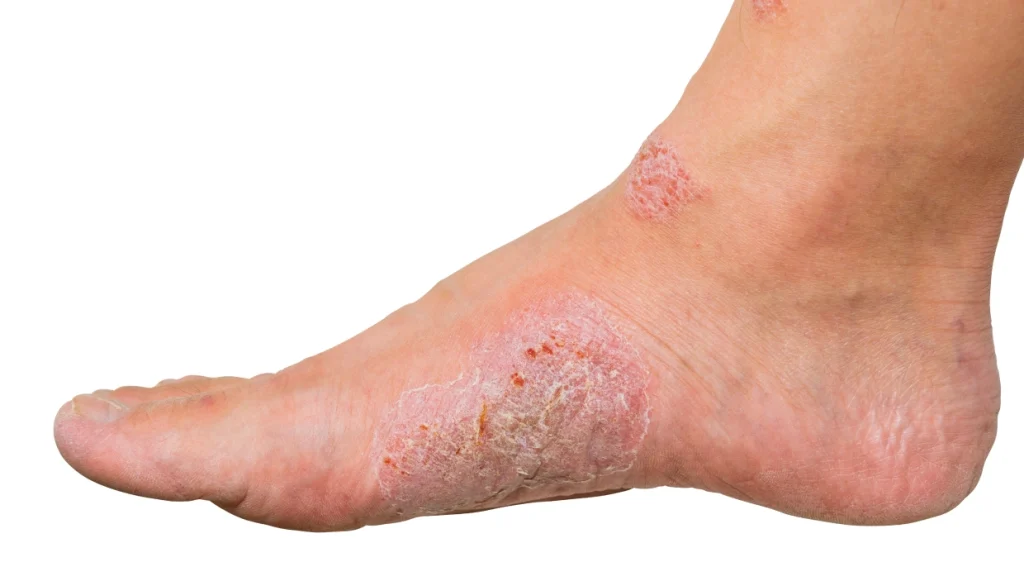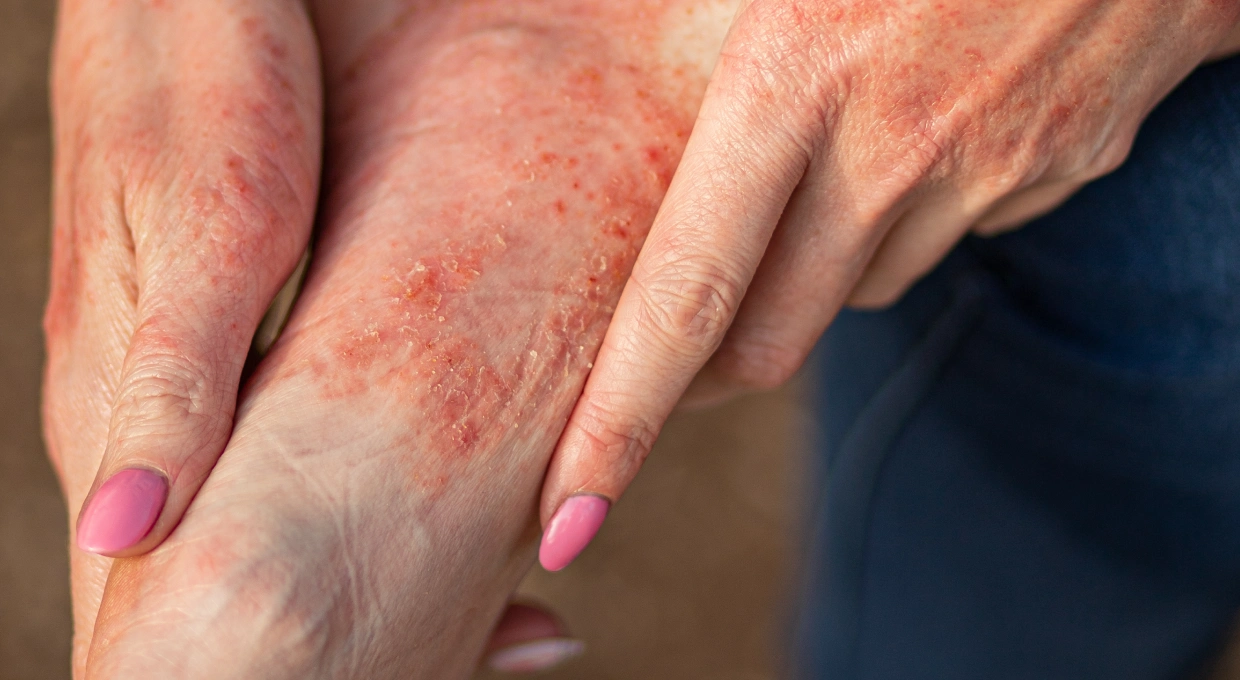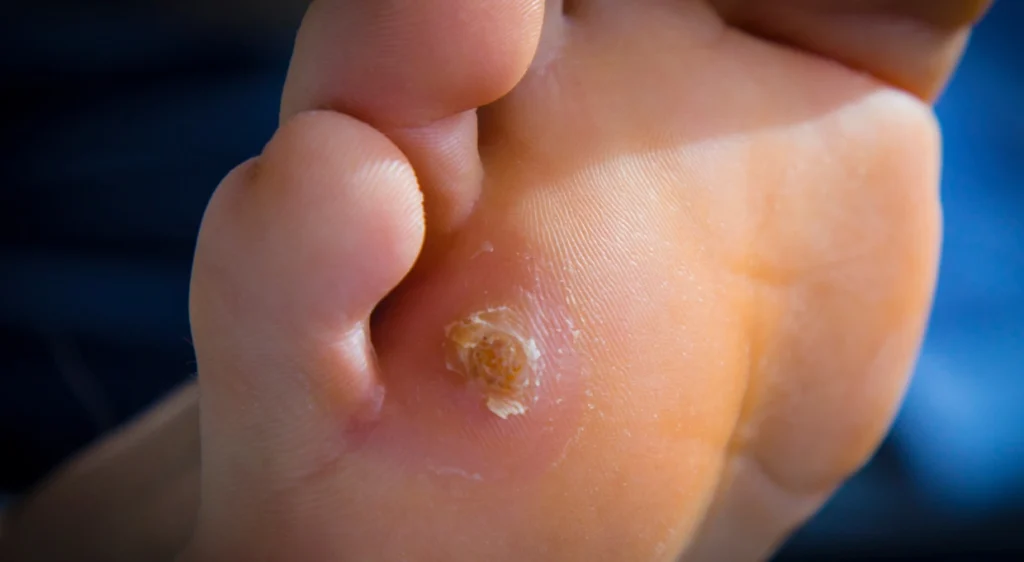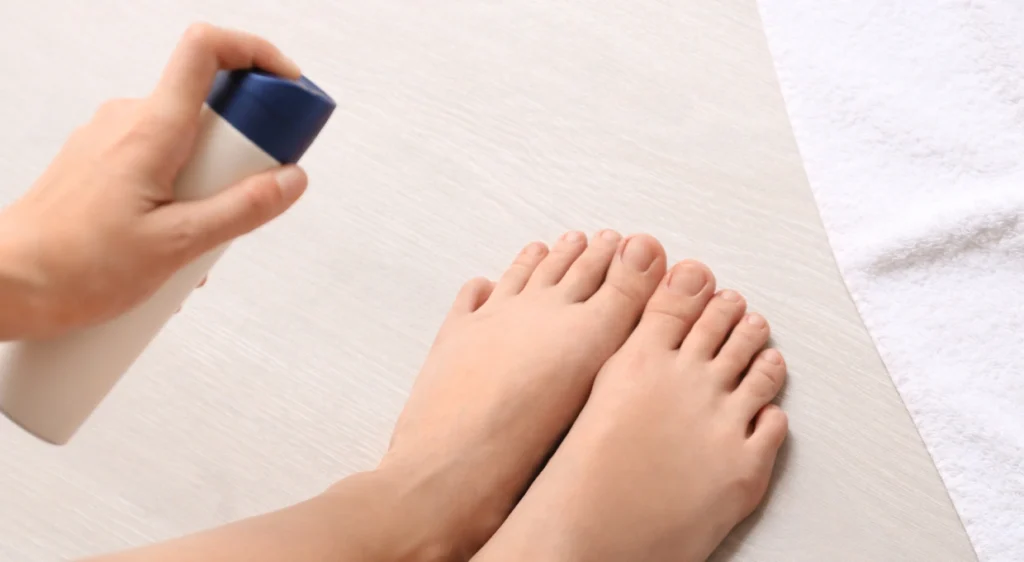Eczema and psoriasis on the feet are two common dermatological conditions that, although they share some symptoms, require different clinical approaches. Both pathologies can cause significant discomfort, affect the patient’s quality of life and become complicated if not treated properly. At Clínica San Román we have specialists in clinical podiatry ready to help you identify and treat these skin diseases from a comprehensive approach.
What is psoriasis?
Psoriasis is a chronic autoimmune inflammatory disease affecting the skin and, in some cases, the joints. It is characterized by the formation of reddened plaques covered with whitish or silvery scales. When it is located on the feet, we speak of palmoplantar psoriasis, a variant that can be painful and make walking difficult.
These plaques appear due to hyperproliferation of skin cells, which are renewed much faster than normal, causing accumulation of dead cells on the skin surface. Psoriasis has a genetic component and can be triggered or aggravated by stress, infections, skin lesions or certain medications.
What is eczema?
Eczema, also known as dermatitis, is an inflammation of the skin that can be due to multiple factors: allergies, irritants, genetics or imbalances in the skin barrier. It affects people of all ages and can appear on different parts of the body, including the feet.
On the feet, eczema usually manifests as redness, intense itching, dry skin, scaling, small blisters or painful cracks. There are different types, the most common being dyshidrotic eczema, which commonly affects the palms and soles, with intense and repetitive outbreaks.
Both conditions may appear similar at first glance, but there are key differences that the podiatric professionals at Clínica San Román evaluate in order to apply the most appropriate treatment.

How to differentiate eczema and psoriasis?
Although eczema and psoriasis may share symptoms such as redness, scaling and itching, there are clinical features that differentiate them:
- Onset: Psoriasis is usually chronic from the beginning, whereas eczema may appear for the first time in childhood or in response to a specific trigger.
- Appearance: Psoriasis plaques are thicker, dry and with silvery scales. In eczema, the skin may be more inflamed, moist or with vesicles.
- Itching: Eczema usually generates more intense itching and may cause constant scratching, which aggravates the lesion. Psoriasis may also be itchy, but it is usually less severe.
- Areas affected: Palmoplantar psoriasis frequently affects the soles, heels and toes. Eczema may be in the same area, but also appears between the toes and on the dorsum of the foot.
- Triggering factors: In eczema, allergic or irritant factors predominate. In psoriasis, immunological and genetic factors play a more important role.
A correct podiatric and dermatological evaluation is key to differentiate both diseases and to rule out other similar pathologies such as fungal infections or keratoderma.
How do I know if I have eczema and psoriasis on my feet?
The accurate diagnosis of these diseases requires a detailed clinical evaluation by a professional. At Clínica San Román we perform a complete clinical history and a thorough examination of the skin of the feet, evaluating aspects such as:
- Type of lesion and anatomical distribution.
- Presence of other symptoms such as fissures, exudate or crusts.
- Family history of skin diseases.
- Possible allergens or risk factors.
- Response to previous treatments.
In doubtful cases, it may be necessary to perform complementary tests such as a skin biopsy or allergy test to confirm the diagnosis and rule out associated infections. Our goal is to offer personalized treatment from day one.
How are both pathologies treated?
The treatment of eczema and psoriasis on the feet must be adapted to the severity, extent and individual characteristics of the patient. At Clínica San Román we apply a comprehensive approach that combines medical treatment, podiatric care and specialized follow-up.
For eczema:
- Use of corticosteroid or immunomodulatory creams to reduce inflammation.
- Daily moisturizing with emollient and fragrance-free products.
- Avoid contact with irritant or allergenic products.
- Use of breathable footwear and cotton socks.
- In severe cases, phototherapy or systemic treatment under medical control.
For psoriasis:
- Application of creams with salicylic acid, tar or vitamin D analogues.
- Topical therapies combined with phototherapy in persistent cases.
- Treatment with immunosuppressive drugs if the disease is extensive or resistant.
- Periodic podiatric care to remove scales and prevent cracks.
Treatment must be constant, since both pathologies have a chronic nature and can present outbreaks if not properly controlled. At Clínica San Román we accompany the patient throughout the process to improve their quality of life and prevent complications.
Do you have any questions about the treatment of eczema and psoriasis on the feet?
If you experience symptoms such as itching, scaly patches or persistent redness on the soles of your feet, toes or heels, you could be suffering from eczema or psoriasis on your feet. At Clínica San Román we offer an accurate diagnosis and personalized treatment to alleviate discomfort and improve the appearance of your skin. Don’t let eczema and psoriasis on your feet limit your daily life. Our team is here to help you.
Why is it important to treat eczema and psoriasis on the feet in time?
Eczema and psoriasis on the feet not only affect the skin, but also the patient’s functionality. When left untreated, both conditions can lead to painful cracks, secondary infections and difficulty walking. In some cases, constant scratching from eczema or excessive thickening from psoriasis can trigger more serious complications that require immediate medical intervention.
Treating eczema and psoriasis on the feet early not only improves the appearance of the skin, but also reduces the risk of relapses, improves the quality of sleep and avoids the prolonged use of aggressive medications. That is why at Clínica San Román we insist on the importance of early diagnosis and professional follow-up of these skin diseases.



